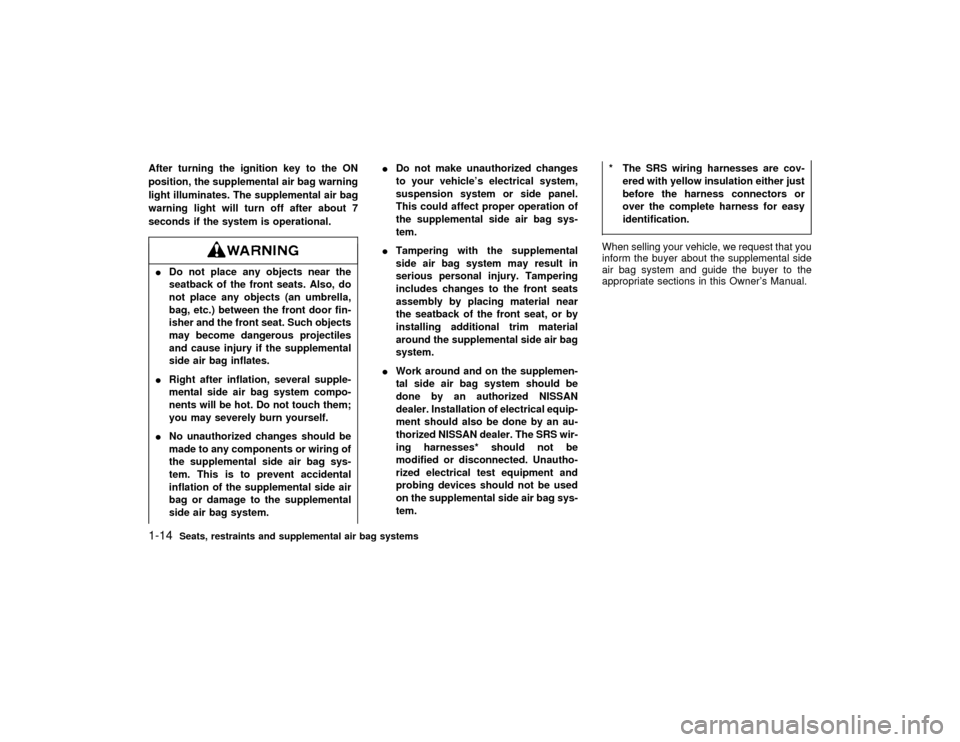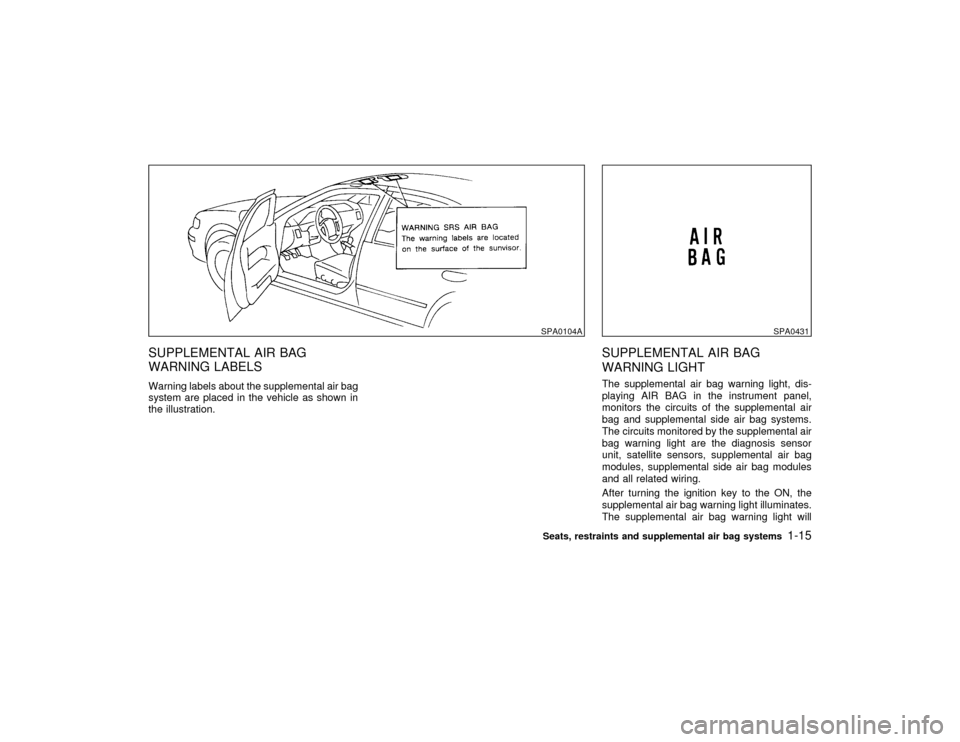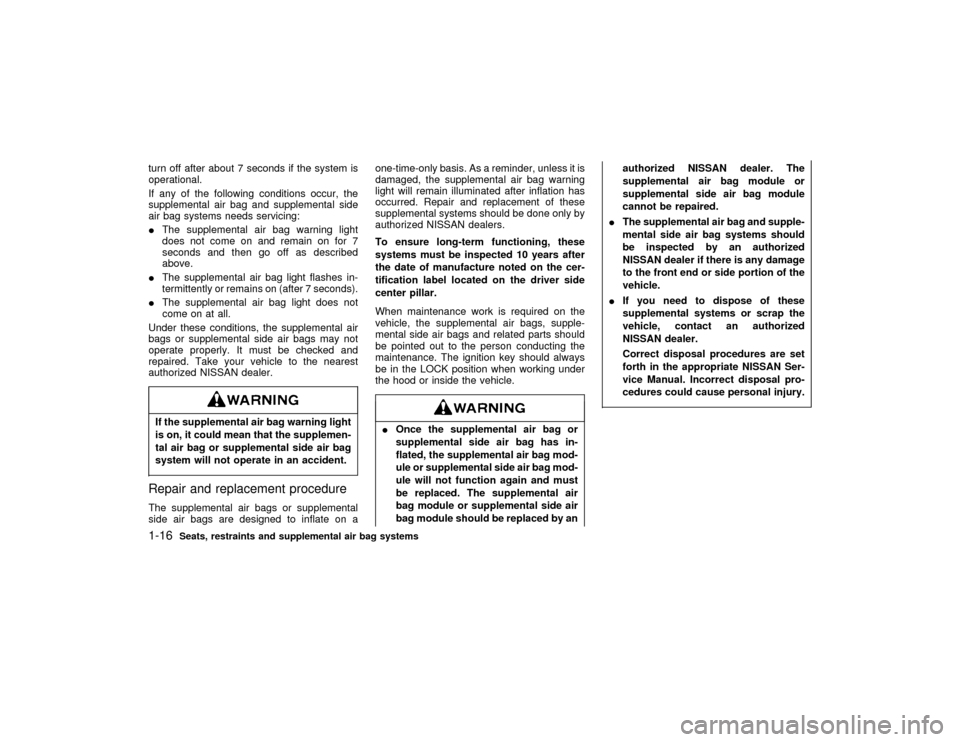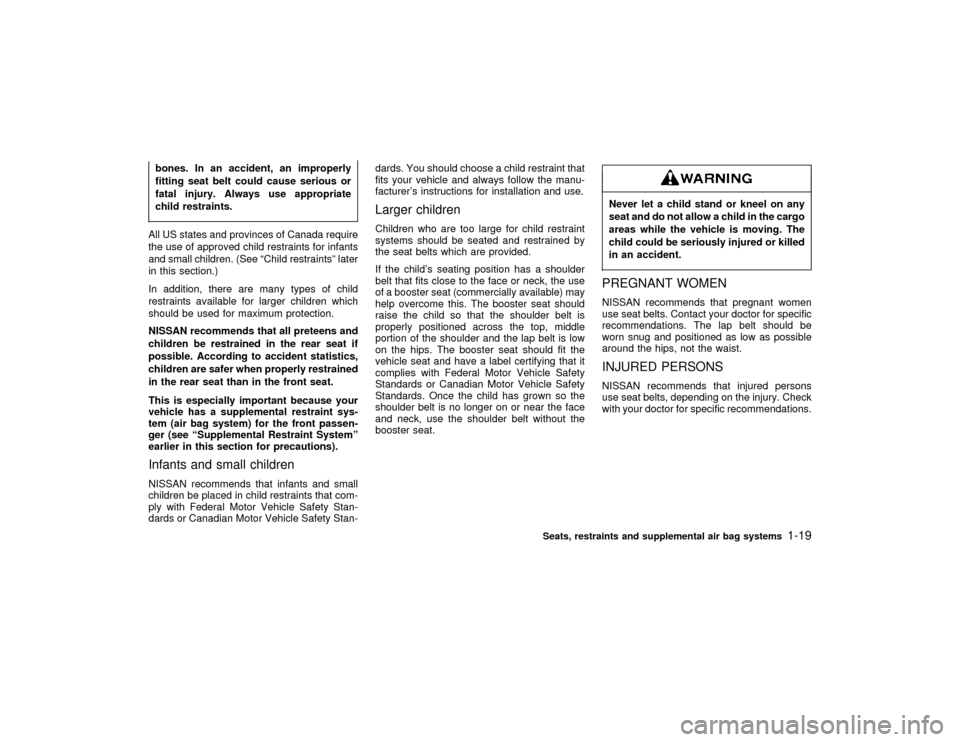NISSAN MAXIMA 1998 A32 / 4.G Owner's Manual
Manufacturer: NISSAN, Model Year: 1998, Model line: MAXIMA, Model: NISSAN MAXIMA 1998 A32 / 4.GPages: 231, PDF Size: 1.94 MB
Page 21 of 231

After turning the ignition key to the ON
position, the supplemental air bag warning
light illuminates. The supplemental air bag
warning light will turn off after about 7
seconds if the system is operational.IDo not place any objects near the
seatback of the front seats. Also, do
not place any objects (an umbrella,
bag, etc.) between the front door fin-
isher and the front seat. Such objects
may become dangerous projectiles
and cause injury if the supplemental
side air bag inflates.
IRight after inflation, several supple-
mental side air bag system compo-
nents will be hot. Do not touch them;
you may severely burn yourself.
INo unauthorized changes should be
made to any components or wiring of
the supplemental side air bag sys-
tem. This is to prevent accidental
inflation of the supplemental side air
bag or damage to the supplemental
side air bag system.IDo not make unauthorized changes
to your vehicle's electrical system,
suspension system or side panel.
This could affect proper operation of
the supplemental side air bag sys-
tem.
ITampering with the supplemental
side air bag system may result in
serious personal injury. Tampering
includes changes to the front seats
assembly by placing material near
the seatback of the front seat, or by
installing additional trim material
around the supplemental side air bag
system.
IWork around and on the supplemen-
tal side air bag system should be
done by an authorized NISSAN
dealer. Installation of electrical equip-
ment should also be done by an au-
thorized NISSAN dealer. The SRS wir-
ing harnesses* should not be
modified or disconnected. Unautho-
rized electrical test equipment and
probing devices should not be used
on the supplemental side air bag sys-
tem.* The SRS wiring harnesses are cov-
ered with yellow insulation either just
before the harness connectors or
over the complete harness for easy
identification.
When selling your vehicle, we request that you
inform the buyer about the supplemental side
air bag system and guide the buyer to the
appropriate sections in this Owner's Manual.
1-14
Seats, restraints and supplemental air bag systems
Z
01.1.31/A32-D
X
Page 22 of 231

SUPPLEMENTAL AIR BAG
WARNING LABELSWarning labels about the supplemental air bag
system are placed in the vehicle as shown in
the illustration.
SUPPLEMENTAL AIR BAG
WARNING LIGHTThe supplemental air bag warning light, dis-
playing AIR BAG in the instrument panel,
monitors the circuits of the supplemental air
bag and supplemental side air bag systems.
The circuits monitored by the supplemental air
bag warning light are the diagnosis sensor
unit, satellite sensors, supplemental air bag
modules, supplemental side air bag modules
and all related wiring.
After turning the ignition key to the ON, the
supplemental air bag warning light illuminates.
The supplemental air bag warning light will
SPA0104A
SPA0431
Seats, restraints and supplemental air bag systems
1-15
Z
01.1.31/A32-D
X
Page 23 of 231

turn off after about 7 seconds if the system is
operational.
If any of the following conditions occur, the
supplemental air bag and supplemental side
air bag systems needs servicing:
IThe supplemental air bag warning light
does not come on and remain on for 7
seconds and then go off as described
above.
IThe supplemental air bag light flashes in-
termittently or remains on (after 7 seconds).
IThe supplemental air bag light does not
come on at all.
Under these conditions, the supplemental air
bags or supplemental side air bags may not
operate properly. It must be checked and
repaired. Take your vehicle to the nearest
authorized NISSAN dealer.If the supplemental air bag warning light
is on, it could mean that the supplemen-
tal air bag or supplemental side air bag
system will not operate in an accident.Repair and replacement procedureThe supplemental air bags or supplemental
side air bags are designed to inflate on aone-time-only basis. As a reminder, unless it is
damaged, the supplemental air bag warning
light will remain illuminated after inflation has
occurred. Repair and replacement of these
supplemental systems should be done only by
authorized NISSAN dealers.
To ensure long-term functioning, these
systems must be inspected 10 years after
the date of manufacture noted on the cer-
tification label located on the driver side
center pillar.
When maintenance work is required on the
vehicle, the supplemental air bags, supple-
mental side air bags and related parts should
be pointed out to the person conducting the
maintenance. The ignition key should always
be in the LOCK position when working under
the hood or inside the vehicle.
IOnce the supplemental air bag or
supplemental side air bag has in-
flated, the supplemental air bag mod-
ule or supplemental side air bag mod-
ule will not function again and must
be replaced. The supplemental air
bag module or supplemental side air
bag module should be replaced by anauthorized NISSAN dealer. The
supplemental air bag module or
supplemental side air bag module
cannot be repaired.
IThe supplemental air bag and supple-
mental side air bag systems should
be inspected by an authorized
NISSAN dealer if there is any damage
to the front end or side portion of the
vehicle.
IIf you need to dispose of these
supplemental systems or scrap the
vehicle, contact an authorized
NISSAN dealer.
Correct disposal procedures are set
forth in the appropriate NISSAN Ser-
vice Manual. Incorrect disposal pro-
cedures could cause personal injury.
1-16
Seats, restraints and supplemental air bag systems
Z
01.1.31/A32-D
X
Page 24 of 231

PRECAUTIONS ON SEAT BELT
USAGEYour chances of being injured or killed in an
accident and/or the severity of injury may be
greatly reduced if you are wearing your seat
belt and it is properly adjusted. NISSAN
strongly encourages you and all of your pas-
sengers to buckle up every time you drive,
even if your seating position includes a supple-
mental air bag.
Most states, provinces or territories require
that seat belts be worn at all times when a
vehicle is being driven.
IEvery person who drives or rides in
this vehicle should use a seat belt at
all times. Children should be properly
restrained and, if appropriate, in a
child restraint.
IThe belt should be properly adjusted
to a snug fit. Failure to do so may
reduce the effectiveness of the entire
restraint system and increase the
chance or severity of injury in an
accident. Serious injury or death can
occur if the seat belt is not worn
properly.
IAlways route the shoulder belt over
your shoulder and across your chest.
Never run the belt behind your backs
under your arm or across your neck.
The belt should be away from your
face and neck, but not falling off your
shoulder.
IPosition the lap belt as low and snug
SSS0013
SSS0012
SEAT BELTS
Seats, restraints and supplemental air bag systems
1-17
Z
01.1.31/A32-D
X
Page 25 of 231

as possible around the hips, not the
waist. A lap belt worn too high could
increase the risk of internal injuries in
an accident.
IBe sure the seat belt tongue is se-
curely fastened to the proper buckle.
IDo not wear the belt inside out or
twisted. Doing so may reduce its ef-
fectiveness.
IDo not allow more than one person to
use the same belt.
INever carry more people in the ve-
hicle than there are seat belts.
IIf the seat belt warning light glows
continuously while the ignition is
turned ON with all doors closed and
all seat belts fastened, it may indicate
a malfunction in the system. Have the
system checked by your NISSAN
dealer.
IAll seat belt assemblies including re-
tractors and attaching hardware
should be inspected after any colli-
sion by your NISSAN dealer. NISSAN
recommends that all seat belt assem-
blies in use during a collision be
replaced unless the collision was mi-
nor and the belts show no damage
and continue to operate properly.
Seat belt assemblies not in use dur-
ing a collision should also be in-
spected and replaced if either dam-
age or improper operation is noted.
CHILD SAFETYChildren need adults to help protect them.
They need to be properly restrained.
The proper restraint depends on the child's
size. Generally, infants (up to about 1 year and
less than 20 lb (9 kg) should be placed in rear
facing child restraints. Front facing child re-
straints are available for children who outgrow
rear facing child restraints.Infants and children need special pro-
tection. The vehicle's seat belts may not
fit them properly. The shoulder belt may
come too close to the face or neck. The
lap belt may not fit over their small hip
SSS0016
SSS0014
1-18
Seats, restraints and supplemental air bag systems
Z
01.1.31/A32-D
X
Page 26 of 231

bones. In an accident, an improperly
fitting seat belt could cause serious or
fatal injury. Always use appropriate
child restraints.All US states and provinces of Canada require
the use of approved child restraints for infants
and small children. (See ªChild restraintsº later
in this section.)
In addition, there are many types of child
restraints available for larger children which
should be used for maximum protection.
NISSAN recommends that all preteens and
children be restrained in the rear seat if
possible. According to accident statistics,
children are safer when properly restrained
in the rear seat than in the front seat.
This is especially important because your
vehicle has a supplemental restraint sys-
tem (air bag system) for the front passen-
ger (see ªSupplemental Restraint Systemº
earlier in this section for precautions).Infants and small childrenNISSAN recommends that infants and small
children be placed in child restraints that com-
ply with Federal Motor Vehicle Safety Stan-
dards or Canadian Motor Vehicle Safety Stan-dards. You should choose a child restraint that
fits your vehicle and always follow the manu-
facturer's instructions for installation and use.
Larger childrenChildren who are too large for child restraint
systems should be seated and restrained by
the seat belts which are provided.
If the child's seating position has a shoulder
belt that fits close to the face or neck, the use
of a booster seat (commercially available) may
help overcome this. The booster seat should
raise the child so that the shoulder belt is
properly positioned across the top, middle
portion of the shoulder and the lap belt is low
on the hips. The booster seat should fit the
vehicle seat and have a label certifying that it
complies with Federal Motor Vehicle Safety
Standards or Canadian Motor Vehicle Safety
Standards. Once the child has grown so the
shoulder belt is no longer on or near the face
and neck, use the shoulder belt without the
booster seat.
Never let a child stand or kneel on any
seat and do not allow a child in the cargo
areas while the vehicle is moving. The
child could be seriously injured or killed
in an accident.PREGNANT WOMENNISSAN recommends that pregnant women
use seat belts. Contact your doctor for specific
recommendations. The lap belt should be
worn snug and positioned as low as possible
around the hips, not the waist.INJURED PERSONSNISSAN recommends that injured persons
use seat belts, depending on the injury. Check
with your doctor for specific recommendations.
Seats, restraints and supplemental air bag systems
1-19
Z
01.1.31/A32-D
X
Page 27 of 231

THREE-POINT TYPE SEAT BELT
WITH RETRACTORIEvery person who drives or rides in
this vehicle should use a seat belt at
all times.
IDo not ride in a moving vehicle when
the seatback is reclined. This can be
dangerous. The shoulder belt will not
be against your body. In an accident
you could be thrown into it and re-
ceive neck or other serious injuries.
You could also slide under the lap
belt and receive serious internal inju-
ries.
IFor most effective protection when
the vehicle is in motion, the seat
should be upright. Always sit well
back in the seat and adjust the seat
belt properly.
Fastening the seat belts1. Adjust the seat.2. Slowly pull the seat belt out of the retractor
and insert the tongue into the buckle until it
snaps.
The retractor is designed to lock during a
sudden stop or on impact. A slow pulling
motion will permit the belt to move, and
allow you some freedom of movement in
the seat.
SSS0018
SSS0020
SSS0102
1-20
Seats, restraints and supplemental air bag systems
Z
01.1.31/A32-D
X
Page 28 of 231

3. Position the lap belt portionlow and snug
on the hipsas shown.
4. Pull the shoulder belt portion toward the
retractor to take up extra slack.
The front passenger side seat belt and rear
three-point seat belts have a cinching mecha-
nism for child restraint installation. It is referred
to as the automatic locking mode.
When the cinching mechanism is activated the
seat belt cannot be withdrawn again until the
seat belt tongue is detached from the buckle
and fully retracted. For additional information,
see ªChild restraintsº later in this section.The automatic locking mode should be
used only for child restraint installation.
During normal seat belt use by a passen-
ger, the locking mode should not be acti-
vated. If it is activated it may cause uncom-
fortable seat belt tension.
Unfastening the seat beltsTo unfasten the belt, press the button on the
buckle. The seat belt will automatically retract.Checking seat belt operationYour seat belt retractors are designed to lock
belt movement using two separate methods:
Iwhen the belt is pulled quickly from the
retractor.
Iwhen the vehicle slows down rapidly.
You can check their operation as follows:
Igrasp the shoulder belt and pull quickly
SSS0061
SSS0021
Seats, restraints and supplemental air bag systems
1-21
Z
01.1.31/A32-D
X
Page 29 of 231

forward. The retractor should lock and re-
strict further belt movement.
If the retractor does not lock during this check
or if you have any questions about belt opera-
tion, see your NISSAN dealer.
Shoulder belt height adjustment
(For front seats)The shoulder belt anchor height should be
adjusted to the position best for you. (See
ªPrecautions on seat belt usageº earlier in this
section.) To adjust, squeeze the release but-
tons, and then move the shoulder belt anchor
to the desired position, so that the belt passes
over the center of the shoulder. The belt
should be away from your face and neck, but
not falling off of your shoulder. Release the
adjustment buttons to lock the shoulder belt
anchor into position.
IAfter adjustment, release the buttons
and try to move the shoulder belt
anchor up and down to make sure it
is securely fixed in position.
IThe shoulder belt anchor height
should be adjusted to the position
best for you. Failure to do so may
reduce the effectiveness of the entire
restraint system and increase the
chance or severity of injury in an
accident.
PD1321-A
1-22
Seats, restraints and supplemental air bag systems
Z
01.1.31/A32-D
X
Page 30 of 231

TWO-POINT TYPE SEAT BELT
WITHOUT RETRACTOR (CENTER
OF REAR SEAT)
Selecting correct set of seat beltsThe center seat belt buckle and tongue are
identified by the CENTER mark. The center
seat belt tongue can be fastenedonlyinto the
center seat belt buckle.
Fastening the seat belts1. Insert the tongue into the buckle marked
CENTER until it snaps.2. To lengthen, hold the tongue at a right
angle to the belt and pull on the belt. To
shorten, pull the end of the belt attached to
the belt clip away from the tongue, and then
pull the belt clip to take up the slack.
SPA0281
SSS0103
SSS0024
Seats, restraints and supplemental air bag systems
1-23
Z
01.1.31/A32-D
X